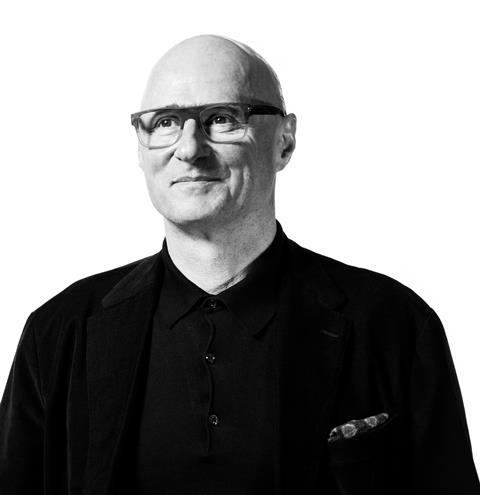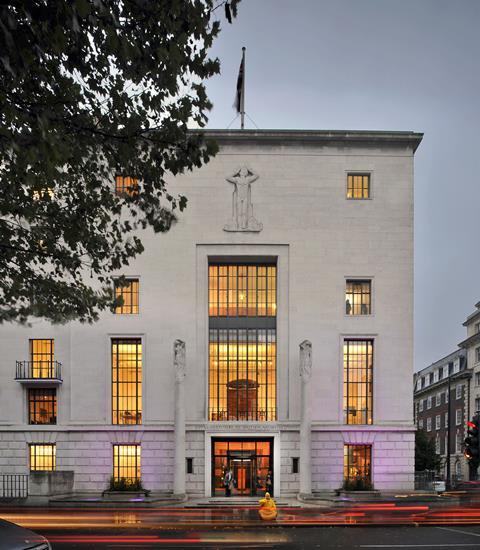Calls for review as ‘pitiful’ 13.2% bother to vote for RIBA president
Simon Allford’s election victory was based on the lowest turnout for more than a quarter of a century, according to research by Building Design.

Just 13.2% of members bothered to vote in this summer’s presidential face-off, despite one of the busiest fields in recent years, with five candidates standing.
That figure drops to just 6.6% among students, associates and affiliates – who had been given the chance to vote for the first time in the institute’s history. The figure for students alone was 5.8%.
Russell Curtis, co-founder of RCKa, dubbed the figures “absolutely pitiful” while others questioned Allford’s mandate and called for an investigation.
Research by Building Design tracked turnout figures back into the last century and found that – despite several lacklustre elections – none appeared to have plumbed this year’s depths since at least the late 1980s. The information was gathered from various sources and it proved difficult to find data going back further.
Jack Pringle, commenting on this year’s figures, said: “If the turnout was low, it just underlines the work we have in front of us to make RIBA relevant to all architects again.”
He backed Allford for the presidency and himself won a seat on council. He said: “I’m delighted to see Simon elected as president, not least because I encouraged him to stand. I’m also encouraged to see such a diverse set of candidates elected and look forward to meeting them all… Lots to do, I’m looking forward to it.”
The last election, in which Alan Jones beat Elsie Owusu and Philip Allsopp after a contentious campaign, saw a 19% turnout.
Two years before that Ben Derbyshire beat Jones and Andrew Salter on a 15.2% turnout, while the election won by Jane Duncan in 2014 was 16.7%.
Ruth Reed and Angela Brady, the first two women presidents of the institute, both won on 18% turnouts.
The early part of the century saw higher voting, with Sunand Prasad winning in 2006 on 27%, Jack Pringle in 2004 with 22% and George Ferguson in 2002 on 24%.
That figure was fractionally bettered by Paul Hyett in 2001 and Marco Goldschmied in 1999, both on about 25%, figures that were described as the lowest for a decade, meaning this year’s turnout could the worst since at least the late 1980s – or even longer.
The best figure in recent times was the 37% who voted in 1997, propelling David Rock to victory.
In 2012 apathy was so bad that there was only one candidate, Stephen Hodder.
At last year’s council elections a paltry 8.4% of members voted, though non-presidential elections always attract less interest.
Yorkshire-based architect and principal designer Stephen Walker, said: “A 13% turnout says an awful lot about the profession and RIBA members themselves.”
Tweet by co-founder of Decolonise Architecture UK:
13% turnout 😬 that’s not much of a mandate, RIBA really isn’t fit for purpose, we need a strong architectural union not a royal society https://t.co/F5BsPgn6J7
— زيد (@z_h_h_t) August 11, 2020
Chris Boyce, founding director of Assorted Skills & Talents, described it as embarrassing, while Russell Curtis tweeted: “RIBA members: ‘The institute does nothing for us.’ Also RIBA members: 13.2%. Absolutely pitiful.”
He added: “The RIBA is so set in its ways that the president actually has very little power – and change would be impossible even if s/he wanted to achieve it. Also, members love to whine but never really want to do anything to change it. Hence the pitiful turnout.”
Past president Ben Derbyshire who worked with Jane Duncan to get students the vote, said they could not be blamed for the low turnout. He said: ”Students are having a really tough time - locked down and remote from their teachers and studios. I can’t blame them if they perceive the world of practice and the wider profession even more remotely. They remain a great resource and are the future of the profession. Perhaps a student council might engage them more directly once the pandemic passes.”
Simeon Shtebunaev, a former RIBA council student member, predicted a much higher turnout at the next election once students realised the impact they could have, and a greater engagement from candidates with schools once they also realised the numbers of votes they could harness.
Jonathon Broughton, founder of Urban Surgery and a former Allies & Morrison associate, said Allford’s victory was “a positive choice and interesting it went to fourth choice votes to clinch it. Once the dust is settled, and the sleeves have been rolled up, perhaps at least a little review into why only 13% of the membership voted?”
Also remarking on the poor turnout, Grimshaw partner Mark Middleton welcomed Allford’s win saying: “I think he will lead the necessary change for our institution.”
Simone de Gale, director of Simone de Gale Architects, who was re-elected to council, said Allford’s success in practice meant he was “well positioned to steer our institute in the current environment”.

But she added: “I am somewhat disappointed in the percentage of electorate turnout. We need to enthuse RIBA members to participate in their representative body. It is the power of the voice of the members which shapes the RIBA.”
Simon Bird, director at LOM architecture and design, said: “The overarching priority for Simon Allford as he steps into the presidency must be to increase its profile, impact and effectiveness. The RIBA needs to build its profile as a platform for positive advocacy, supporting the profession while reaching out to the private sector and government to make the case for architects as innovative, commercially minded drivers of creativity and growth.
“As an industry, we need to be speaking with one clear voice, and the role of RIBA president is instrumental to helping us be heard more loudly.”
New RIAS president Christina Gaiger issued a statement congratulating Allford, adding: “I wish him all the best for the role and very much look forward to working with him to continue to strengthen our joint public message around the value of an architect.”
RIBA’s response
RIBA president Alan Jones said: “In the context of an unsettling global pandemic and its economic consequences, the RIBA election was unlikely to be at the top of everyone’s agenda – but I am pleased to see that a healthy proportion (17.2%) of chartered members voted.
”Turnout among over 15,000 newly enfranchised student members lower than I had hoped for (5.8%) – contributing to the dip in the overall turnout – but I do appreciate that the timing of the election, outside of the academic term, will have made it more difficult to encourage students to participate. We will be carefully reviewing the date of future elections to ensure we engage as many student members as possible.
”These elections are also just one of countless ways that our members get involved. Whether they support local branch activities, advise one of our expert groups, or engage with our Future Architects Network, the RIBA has an enviable network of extremely engaged members – and there is always room for improvement.”
>> Also read: Simon Allford wins RIBA presidential election
>> Also read: RIAS elects youngest president in its history
Turnouts at RIBA presidential elections
2021-2023 Simon Allford – 13.2%
2019-2021 Alan Jones – 19%
2017–2019 Ben Derbyshire – 15.2%
2015–2017 Jane Duncan – 16.7%
2013–2015 Stephen Hodder – uncontested
2011–2013 Angela Brady – 18%
2009–2011 Ruth Reed – 18%
2007–2009 Sunand Prasad – 27%
2005–2007 Jack Pringle – 22%
2003–2005 George Ferguson – 24%
2001–2003 Paul Hyett – 24.5%
1999–2001 Marco Goldschmied – 25% (described as worst for a decade in a 2009 LSE PhD thesis)
1997–1999 David Rock – 37%
















10 Readers' comments